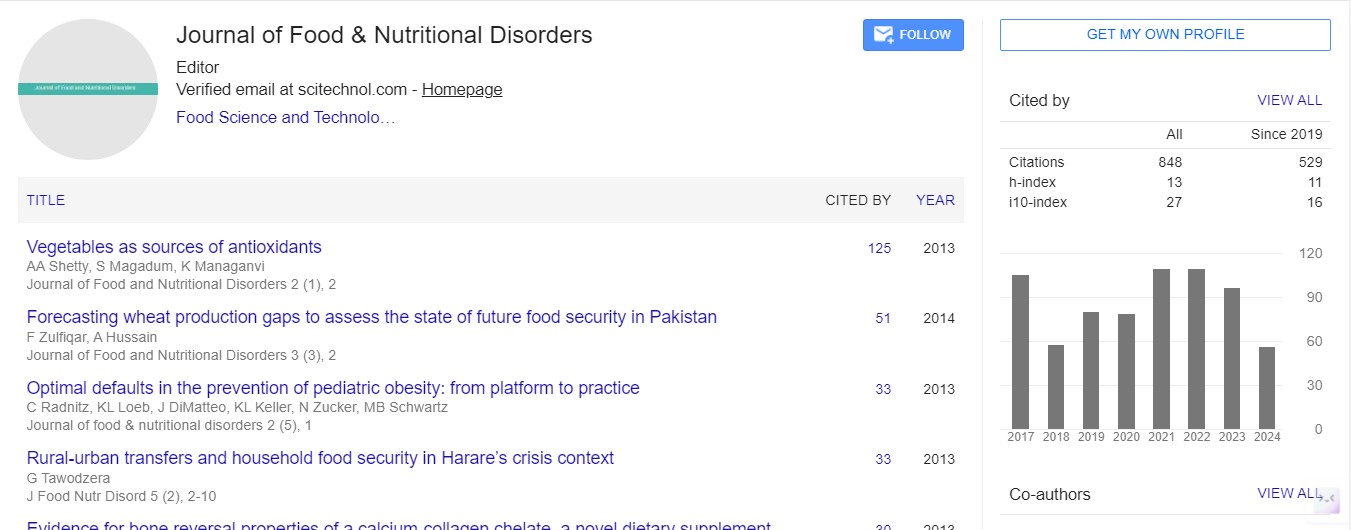Comparison of molecularly imprinted polymers and antibodies as artificial and native receptors in the assays of antibiotics
Olga D. Hendrickson, Tarannum N, Zherdev A.V and Dzantiev B. B
A.N. Bach Institute of Biochemistry, Russia
Chaudhary Charan Singh University, India
: J Food Nutr Disor
Abstract
Statement: The use of antibiotics in veterinary medicine raises serious concerns about food contamination. Therefore, the development of sensitive and rapid analytical techniques to control antibiotics in food products is now the task of great demand. Although immunoanalytical methods have wide applications for this purpose, protein nature of antibodies causes several drawbacks of immunoassays. Thereby, Molecularly Imprinted Polymers (MIPs) as artificial receptors can replace antibodies and serve as an alternative analytical tool for recognition of antibiotics.
Methodology and Theoretical Orientation: The detection of Ciprofloxacin (CIP) and Chloramphenicol (CAP) by a Fluorescent Polarization Immunoassay (FPIA) and Enzyme-linked immunoassay (ELISA) as traditional immunoassay formats and MIP-based analysis was compared in this study supported by the Russian Foundation for Basic Research (Project 17-58-45128-Ind_ð) and the Department of Science and Technology of the Ministry of Science and Technology of India (project INT/RUS/RFBR/P-292, 20/10/2017). MIPs composed from methacrylic acid, chitosan and gold nanoparticles were prepared on the surface of microplate wells. The assays were carried out in a competitive format using antibiotic–fluorescein or antibiotic–enzyme conjugates.
Findings: The developed ELISA and FPIA allowed for the determination of CIP and CAP with detection limits in milk varied from 0.05 to 1 ng/mL depending on the label within 1 h. Specific interactions of the MIP and analytes were observed. MIP-based analysis was carried out within 30 min. However, in the selected assay conditions, the nonspecific binding of MIP was much higher than in the case of using native receptors, antibodies, thus reducing the reproducibility and sensitivity of MIP-based analysis.
Conclusion and Significance: The applicability of MIPs for the detection of antibiotics was demonstrated. The analytical characteristics of the developed assays based on antibodies were higher than those in MIP-based test systems. Therefore, using antibodies in the analysis of antibiotics in real multicomponent samples are preferable.
Recent Publications
1. Darwish IA (2006) Immunoassay methods and their applications in pharmaceutical analysis: Basic methodology and recent advances. Int. J. Biomed. Sci. 2:217-235.
2. Chafer-Pericás C, Maquieira A, Puchades R (2010) Fast screening methods to detect antibiotic residues in food samples. TrAC Trends Anal Chem 29:1038-1049.
3. Chen L, Wang X, Lu W, Wu X, Li J (2016) Molecular imprinting: Perspectives and applications. Chem Soc Rev 45:2137-2211.
4. Cieplak M, Kutner W (2016) Artificial biosensors: How can molecular imprinting mimic biorecognition? Trends Biotechnol 34:922-941.
5. Chen C, Luo J, Li C, Ma M, Yu W, Shen J, Wang Z (2018) Molecularly imprinted polymer as an antibody substitution in pseudo-immunoassays for chemical contaminants in food and environmental samples. J Agric Food Chem 66:2561-2571.
Biography
Olga D. Hendrickson has completed his PhD in A.N. Bach Institute of Biochemistry, Russian Academy of Sciences, Moscow, Russia. Now she is a Senior Researcher in the Immunobiochemistry Laboratory of Federal Research Center “Fundamentals of Biotechnology” of the Russian Academy of Sciences. Her scientific interests include quantitative studies of immune complexes’ formation, interaction of nanoparticles with biomolecules, structural bases of interactions with bioreceptors, biosensor systems, development of new immunochemical methods for the detection of biologically active compounds, Nano biosafety issues, methods for quality control and safety of food and feed, etc. She has published more than 30 papers in reputed journals.
E-mail: odhendrick@gmail.com
 Spanish
Spanish  Chinese
Chinese  Russian
Russian  German
German  French
French  Japanese
Japanese  Portuguese
Portuguese  Hindi
Hindi 
